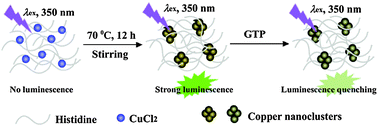Water-soluble luminescent copper nanoclusters reduced and protected by histidine for sensing of guanosine 5′-triphosphate†
Abstract
A one step synthesis of water-soluble luminescent copper nanoclusters (CuNCs) reduced and protected by histidine is reported. When excited at 350 nm, the as-synthesized CuNCs exhibit luminescence centered at 456 nm with a quantum yield of 1.6%, which is different from that of histidine alone under the same experimental conditions. Upon addition of guanosine 5′-triphosphate (GTP), the emission of CuNCs is gradually quenched. While other nucleoside triphosphates including ATP, CTP and UTP as well as some inorganic anions such as P2O74−, PO43−, and CH3COO− have no such quenching effect, which indicates that the nucleobase instead of the phosphate anion plays an important role in the emission quenching of CuNCs. The most efficient quenching of the CuNCs induced by GTP can be ascribed to the most reducing ability of guanine among the other nucleobases. This interesting experimental result demonstrates that the as-synthesized CuNCs can be applied to sensing of GTP.


 Please wait while we load your content...
Please wait while we load your content...